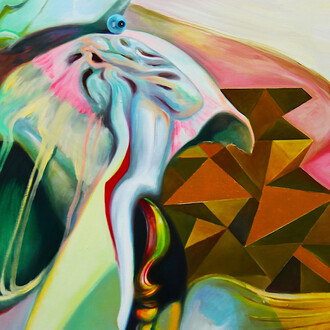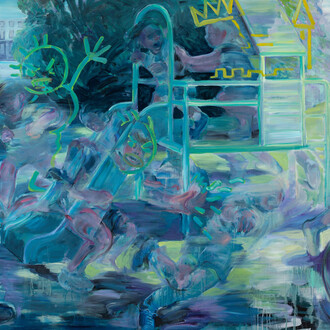In Forcing connections, Dennis Osadebe invites viewers to challenge their perceptions of the relationship between ancestral and contemporary technologies. Through a distinct visual language, he unveils unexpected resonances and possibilities, weaving a seamless dialogue between seemingly contradictory yet complementary elements. This exhibition represents a maturation in Osadebe's practice, more deliberately rooted in his exploration of Nigerian identity in a global context. Working primarily in acrylic on canvas, alongside locally sourced materials for his sculpture, he grounds his vision in both traditional and contemporary practice. The works in this exhibition reveal Osadebe's understanding of the creative process as one of investigation rather than assertion, raising questions rather than imposing answers.
The exhibition features vibrant works where ancestral technologies, such as traditional African masks (reminiscent of the Queen Idia mask, from the Benin Kingdom in Nigeria), ceremonial fans, and sculptures, coexist with contemporary technologies such as smartphones, headphones, and digital devices. Osadebe evokes emotions, invokes history, and provokes contemplation as he employs characteristically bold colors and clean lines to create compositions that feel both surprising and natural. The resulting visual language is simultaneously rooted in Nigerian cultural heritage and fluent in the aesthetic vocabulary of global digital culture.
"I'm playing with this idea of tradition and the future," Osadebe explains. "In every city, there's a traditional side that inspires the future, and there's always that clash. Young people fight for the future, sometimes putting down the soul and heartbeat of where culture is born."
The exhibition highlights how objects once considered innovations now represent cultural heritage. A traditional wooden mask becomes an enduring object that outlasts its creator, while modern technology constantly updates, its relevance quickly overshadowed by newer iterations.
In works like Balance, where masked figures in vibrant dress hold ceremonial objects connected to modern devices, and The great experiment, featuring subjects with both cultural artifacts and contemporary technology, Osadebe explores themes of connection and coexistence. Osadebe creates what might be called “productive contamination” with juxtapositions that suggest continuity rather than rupture across time, offering a hybrid space where tradition and technology enrich each other.
Drawing from mid-20th century West African photography, Osadebe found particular inspiration in the works of Malian photographers like Seydou Keïta, Malick Sidibé, Adama Kouyaté. He is fascinated by the sense of duality in their photographs, where similarly dressed figures foster connections through deliberate posing. Osadebe evokes this same feeling of connection in Balance, The great experiment, and Positive and negative without simply duplicating it, presenting his subjects with a seriousness that recalls the formal portraiture tradition while incorporating contemporary elements.
In the Still life series, Osadebe arranges ancestral objects alongside modern devices on patterned surfaces reminiscent of West African textiles. These compositions draw inspiration from both European still life traditions and the way West African photographers used props to signify cosmopolitanism and modernity. In this series, Osadebe reimagines the still life genre through an African gaze, suggesting that what might appear as a Western artistic tradition has indigenous parallels, drawing influence from how photographers like Sidibé and Keïta deliberately arranged objects to communicate cultural meaning.
Another particular source of influence is Adama Kouyaté’s Untitled Bouaké, which features a clothed reclining figure of a woman listening to a radio—a reimagining of a motif traditionally depicted as nude in Western art. Osadebe replicates this engagement with cultural reinterpretation in the Forcing connections series and Untitled sculpture, where figures pose formally as if for photographs while interacting with ancestral sources of connection and contemporary sources of connection. The contrast between their serious demeanor and the playful juxtapositions creates a productive tension throughout the exhibition.
The question "What could emerge from the exchange?" guided Osadebe throughout this body of work. By forcing connections between disparate elements, he invites viewers to consider: Can past and future speak the same language? Can technology preserve traditional wisdom? Can tradition and innovation coexist?
Forcing Connections doesn't provide definitive answers but creates a space for viewers to find personal resonances. Some might see technology as a tool for preserving culture; others might be reminded of traditional craftsmanship's enduring value. All are invited into a conversation about harmonizing the timeless with the transient in our increasingly digital world.
Through these works, Osadebe reminds us that neither technology nor tradition exists in isolation—they inform and enrich each other, challenging us to embrace both as integral parts of our shared cultural experience. Challenging us to reflect on our own relationship with tradition and technology, considering what might emerge from our forced connections
(Text by Innocent Ekejiuba, May 2025)














